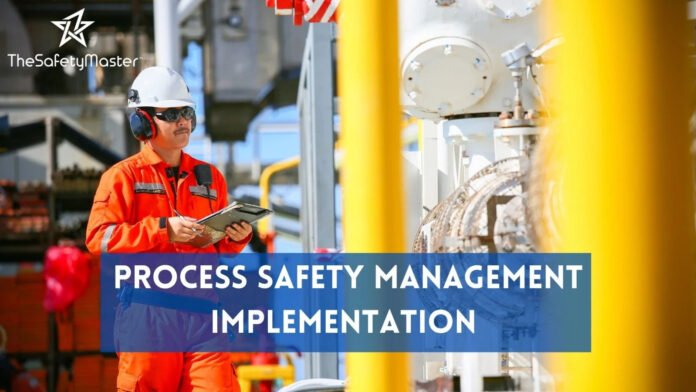In today’s industrial landscape, ensuring safety is not just a regulatory requirement but a critical aspect of operational excellence. Process Safety Management (PSM) is a comprehensive approach designed to identify, assess, and mitigate risks associated with hazardous processes. As a Safety Master, overseeing the implementation of PSM protocols is crucial for maintaining safety and compliance. This guide explores best practices for Safety Masters in Process Safety Management, offering valuable lessons and insights to enhance effectiveness and promote a culture of safety.
Understanding the Role of a Safety Master
A Safety Master is pivotal in managing and overseeing safety protocols, particularly in complex and hazardous environments. Their role encompasses a broad range of responsibilities, including ensuring compliance with safety regulations, conducting audits, and fostering a culture of safety within the organization.
Key Responsibilities of a Safety Master
- Regulatory Compliance: Ensuring that all safety practices align with local, national, and international regulations.
- Safety Audits: Conducting regular safety audits, including Fire Safety Audit, to identify and address potential hazards.
- Training and Development: Providing ongoing training and development opportunities to staff to enhance safety awareness and skills.
- Incident Investigation: Leading investigations into safety incidents to identify root causes and implement corrective actions.
Best Practices in Process Safety Management
To excel in the role of a Safety Master, implementing best practices in Process Safety Management is essential. Here are some key strategies to enhance the effectiveness of PSM efforts:
1. Develop a Comprehensive Safety Plan
A robust safety plan serves as the foundation for effective Process Safety Management. This plan should include detailed procedures for identifying hazards, assessing risks, and implementing control measures. Regularly review and update the safety plan to reflect changes in processes, regulations, and industry best practices.
- Risk Assessment: Conduct thorough risk assessments to identify potential hazards associated with hazardous processes.
- Control Measures: Implement appropriate control measures to mitigate identified risks and ensure the safety of personnel and equipment.
2. Implement Robust Safety Procedures
Clear and effective safety procedures are critical for maintaining a safe working environment. Ensure that all safety procedures are well-documented, communicated to staff, and regularly reviewed for effectiveness.
- Standard Operating Procedures (SOPs): Develop and maintain SOPs for all critical processes, ensuring they are accessible and understood by all employees.
- Emergency Response Plans: Establish and communicate emergency response plans to prepare for and manage potential incidents.
3. Conduct Regular Safety Audits
Regular safety audits are essential for identifying potential safety issues and ensuring compliance with safety regulations. Audits should include both scheduled and unscheduled assessments to provide a comprehensive view of safety performance.
- Process Safety Management Audits: Perform regular Process Safety Management audits to evaluate the effectiveness of safety measures and identify areas for improvement.
- Fire Safety Audits: Conduct periodic Fire Safety Audits to assess fire safety measures and ensure they meet regulatory standards.
4. Foster a Culture of Safety
Creating a strong safety culture is crucial for the long-term success of PSM initiatives. Encourage open communication about safety issues, promote proactive safety behaviors, and recognize and reward safety achievements.
- Safety Communication: Foster open communication channels for reporting safety concerns and near-misses.
- Employee Engagement: Engage employees in safety initiatives and provide opportunities for them to contribute to safety improvements.
5. Invest in Training and Development
Ongoing training and development are vital for ensuring that all employees are equipped with the knowledge and skills needed to maintain a safe working environment. Provide regular training sessions and refreshers to keep staff up-to-date with the latest safety practices and regulations.
- Training Programs: Develop and deliver training programs on safety procedures, emergency response, and hazard recognition.
- Continuous Improvement: Encourage employees to seek additional training and certifications to enhance their safety competencies.
6. Leverage Technology for Safety Management
Advancements in technology can significantly enhance safety management efforts. Utilize technology to streamline safety processes, improve data accuracy, and enhance communication.
- Safety Management Software: Implement safety management software to track safety performance, manage audits, and monitor compliance.
- Data Analytics: Use data analytics to identify trends and patterns in safety performance, enabling more informed decision-making.
Lessons Learned and Insights
Through experience, Safety Masters can gain valuable insights into effective PSM practices. Key lessons include the importance of proactive risk management, the value of regular safety audits, and the need for continuous improvement in safety practices.
- Proactive Risk Management: Addressing potential hazards before they escalate is crucial for preventing incidents and maintaining safety.
- Continuous Improvement: Regularly review and update safety practices to adapt to changing conditions and new industry standards.
Conclusion
Mastering Process Safety Management requires a combination of strategic planning, rigorous implementation, and continuous improvement. By adopting best practices, conducting regular audits, fostering a safety culture, and leveraging technology, Safety Masters can effectively manage safety risks and ensure compliance with safety regulations. For more information on effective safety practices, visit The Safety Master’s Process Safety Management and Fire Safety Audit resources. Your commitment to safety is not just a regulatory obligation but a crucial component of operational excellence and employee well-being.



